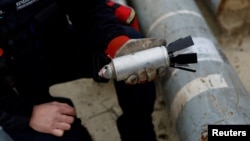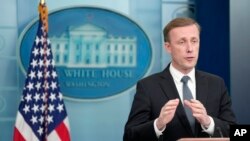The United States is moving ahead with plans to provide Ukraine with a deadly and controversial weapon as part of a new $800 million security package aimed at bolstering Kyiv’s counteroffensive against Russia.
For the first time since Russian troops invaded Ukraine last year, the U.S. will provide Ukraine with cluster munitions — shells or bombs that open in midair — capable of spreading hundreds of smaller charges, or bomblets, over a wide area.
The munitions can inflict heavy casualties in civilian areas and are banned under a 2010 treaty signed by 111 countries. But Russia and Ukraine, which have both used cluster munitions during the conflict, are not signatories. The U.S. also has never signed the convention.
"We recognize that cluster munitions create a risk of civilian harm from unexploded ordnance,” White House national security adviser Jake Sullivan told reporters Friday. “But there is also a massive risk of civilian harm if Russian troops and tanks roll over Ukrainian positions and take more Ukrainian territory and subjugate more Ukrainian civilians because Ukraine doesn’t have enough artillery.
“That is intolerable,” he added.
U.S. officials declined to say just how many rounds of cluster munitions Washington will send Ukraine as part of the new aid package, although they said the new munitions, in the form of 155 mm artillery rounds, will arrive in time to help Ukrainian forces with the current counteroffensive.
Sullivan said the decision to provide Ukraine with cluster munitions was not an easy one and was made by President Joe Biden after consultations with U.S. allies and lawmakers, and after “a unanimous recommendation from his national security team."
U.S. law generally prohibits the transfer of cluster munitions with failure rates of more than 1%, but Sullivan said Biden signed a waiver allowing the move because of national security needs.
Pentagon officials Friday also defended the decision to provide Ukraine with cluster munitions.
“We want to make sure that the Ukrainians have sufficient artillery to keep them in the fight,” Undersecretary of Defense for Policy Colin Kahl told reporters, citing what he called “the urgency of the moment.”
“The worst thing for civilians in Ukraine is for Russia to win the war,” he said, noting the Ukrainian counteroffensive has not made progress as quickly as many had hoped.
“It’s been hard sledding because the Russians had six months to dig in,” Kahl said. “Those defensive belts that the Russians have put in place in the east and the south are hard.”
Ukraine has been asking for additional cluster munitions for months, saying they are critical to its efforts to push back Russian forces.
“The transfer of additional volumes of shells to Ukraine is a very significant contribution to the acceleration of deoccupation procedures," Ukrainian presidential political adviser Mykhailo Podolyak told Reuters ahead of the U.S. announcement. "Especially if we are talking about cluster ammunition, which is undoubtedly capable of having an extraordinary psychoemotional impact on already demoralized Russian occupation groups."
Until now, the U.S. had been reluctant to provide Ukraine with cluster munitions, prioritizing other types of weapons and systems. That thinking seemed to change in recent weeks, though, as Ukraine’s long-anticipated counteroffensive struggled to retake ground.
Human rights groups and activists have long opposed the use of cluster munitions, pointing to high failure or dud rates, which leave areas saturated with unexploded bomblets.
“If they fall or land on your home or a populated area, it can be devastating,” Mary Wareham, the acting director of Human Rights Watch’s Arms Division, told VOA.
“When they fail, you have unexploded submunitions lying around that endanger civilians, endanger de-miners, that have to be cleared, that have to be destroyed,” she said. “It’s a very time-consuming and costly exercise.”
Wareham acknowledged Russia has been “using hundreds of cluster munitions since the very first day” of its latest invasion. But she added, “that doesn’t mean Ukraine should also be using this prohibited weapon.”
A report issued by the Cluster Munition Monitor last year found that through the first five months of Russian’s latest invasion of Ukraine, at least 215 Ukrainians — almost all civilians — were killed and another 474 were injured in Russian attacks using cluster munitions.
“Cluster munition use in Ukraine mostly affected civilian infrastructure, with attacks damaging homes, hospitals, schools, playgrounds, and in one instance a cemetery where mourners were among the casualties,” the report said.
U.S. officials said Friday that Ukraine has given the U.S. written assurances it will not use the U.S.-made cluster munitions in urban areas and that Ukrainian forces would track when and where such munitions were used to facilitate clearing efforts once the fighting is over.
“We welcome the decision of the U.S. to provide Ukraine with the new liberation weapons that will significantly help us to de-occupy our territories while saving the lives of the Ukrainian soldiers,” Ukrainian Defense Minister Oleksii Reznikov posted on social media Friday, backing the U.S. statements that use of the munitions would be closely monitored and tracked.
“Ukraine will use these munitions only for the de-occupation of our internationally recognized territories,” he wrote. “These munitions will not be used on the officially recognized territory of Russia.”
Ukraine’s ambassador to the U.S. gave similar assurances in an interview with VOA.
“We Ukrainians will be using them very, very responsibly because it's our territory, it’s our people we are liberating,” Oksana Markarova said. “And we have shown [a] number of times that we are actually doing this, and we are not only adhering to all the conventions [with cluster munitions] but we also are very responsible in in its usage.”
The U.S. also pushed back against allegations that U.S.-made cluster munitions present the same type of threat to civilians as the ones being used by Russia.
Both Sullivan and Kahl said Russia has been deploying cluster munitions with dud rates of 30% to 40%, while the U.S. is sending Ukraine cluster munitions that have undergone repeated testing to ensure failure rates of less than 2.5%.
There are questions, however, about how much of a difference U.S.-provided cluster munitions will make on the battlefield.
“I don’t expect the cluster munitions to be game changers,” Brookings Institution senior fellow Michael O’Hanlon told VOA in an email.
“I think cluster munitions can help tactically, like artillery, by forcing Russian troops manning defensive positions to seek cover when Ukrainian vehicles are attempting an offensive,” he wrote. “That said, Ukraine has already had artillery (albeit not enough), and Russian troops can still take partial cover while maintaining their positions.”
Other experts agree.
“There’s no such thing as a game changer … but it will help,” Mark Cancian, a retired U.S. Marine colonel and senior adviser with the Center for Strategic and International Studies, told VOA.
“Cluster munitions are very good against area targets, targets that are spread out,” like infantry and truck convoys, he said, noting the use of cluster munitions could slow the rapid pace at which Ukraine’s military is going through standard munitions.
It could also take pressure off the U.S. and other countries that have been providing Ukraine with ammunition and artillery as their own stockpiles dwindle.
“The stocks of regular munitions are quite low and it’s not clear how much more we can give them,” Cancian said.
U.S. officials Friday admitted that concerns about ammunition stockpiles factored into the decision to give Ukraine the cluster munitions.
"We are reaching a point in this conflict, because of the dramatically high expenditure rates of artillery by Ukraine and by Russia, where we need to build a bridge from where we are to today to where we have enough monthly production of unitary rounds that unitary rounds alone will suffice to give Ukraine what it needs," Sullivan said.
VOA Russian’s Liliya Anisimova and VOA’s Ukrainian Service contributed to this report.










